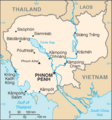2013–14 Cambodian protests facts for kids
The Cambodian protests were a series of large demonstrations in Cambodia that started in July 2013. People gathered in the capital city, Phnom Penh, to protest against the government led by Prime Minister Hun Sen.
There were several reasons for these protests. Many people believed there was election fraud during the general election of 2013. Protesters also wanted the minimum wage (the lowest amount of money workers can be paid) to be increased to $160 a month. Some people were also unhappy about Vietnam's influence in Cambodia. Cambodia is a poor country, and many felt the government wasn't doing enough to help. The main opposition party, the Cambodia National Rescue Party (CNRP), refused to join parliament after the elections because of their concerns. Big protests happened throughout December 2013. In January 2014, the government acted, which sadly led to four people dying and the main protest area being cleared.
Contents
Why Did Protests Start?
Hun Sen had been the prime minister of Cambodia for 28 years. He was the leader of the Cambodian People's Party (CPP). In 2013, he faced a challenge from Sam Rainsy, who led the Cambodia National Rescue Party (CNRP).
The general elections were held on July 28, 2013. The ruling Cambodian People's Party said they won by getting 68 seats in Parliament. However, the Cambodia National Rescue Party, which won 55 seats, did not accept the election results. They refused to attend the opening of parliament. The CNRP said there were problems with how the votes were counted. Even the European Union and the United States were worried about possible fraud. A group called Human Rights Watch, which helps people's rights, asked for an independent group to look into the election fraud claims.
Protests in September 2013
In September 2013, security police clashed with Cambodian protesters. Police blocked two main roads leading into Phnom Penh. During these clashes, police shot and killed one protester. Three other people were seriously injured. Ten people were also arrested. Police used firearms and tear gas against the protesters. The protesters broke a barrier in the road and threw rocks and other things at the police. One policeman was injured. This happened just before planned talks between Prime Minister Hun Sen and CNRP leader Sam Rainsy.
Protests in November 2013
In November 2013, a woman was shot and nine others were hurt during protests by clothing workers in Phnom Penh. More than a dozen people, including several monks, were arrested during these events.
Protests in December 2013
On December 27, 2013, garment workers who were on strike clashed with police on a road outside Phnom Penh. The opposition party also organized large protests in Phnom Penh during December, including motorbike rallies. The government said these protests were against the law and were causing "anarchy," meaning disorder.
Protests in January 2014
On January 3, at least four people were shot and killed, and 20 others were injured. This happened when police fired into a crowd of garment workers. The workers were demanding that their minimum wage be doubled. They had blocked the road with burning tires. Protesters also threw objects at the police. By this time, most workers at Cambodia's 500 factories were on strike. They still wanted a $160 monthly minimum wage, but the government had offered only $100. This was the second day of strikes and clashes with police.
The opposition party and anti-government protesters had strong connections with the labor movement. Unions representing unhappy garment workers joined the protests with opposition supporters against Prime Minister Hun Sen's government. They wanted a new election. Sam Rainsy, the CNRP leader, promised to almost double the wage to $160 if the CNRP won a new election.
On January 4, 2014, Cambodian officials removed a camp where anti-government demonstrators had been staying. The government also rejected an application for a new TV channel, saying there was no frequency available. All local TV channels are closely connected to Prime Minister Hun Sen.
Gallery
Images for kids
-
CNRP President Sam Rainsy and Vice President Kem Sokha wave to protesters during a demonstration in December 2013.
-
A young protester screams for Prime Minister Hun Sen to step down on the final day of a three-day rally by the opposition.
See also
 In Spanish: Protestas de Camboya de 2013-2014 para niños
In Spanish: Protestas de Camboya de 2013-2014 para niños










